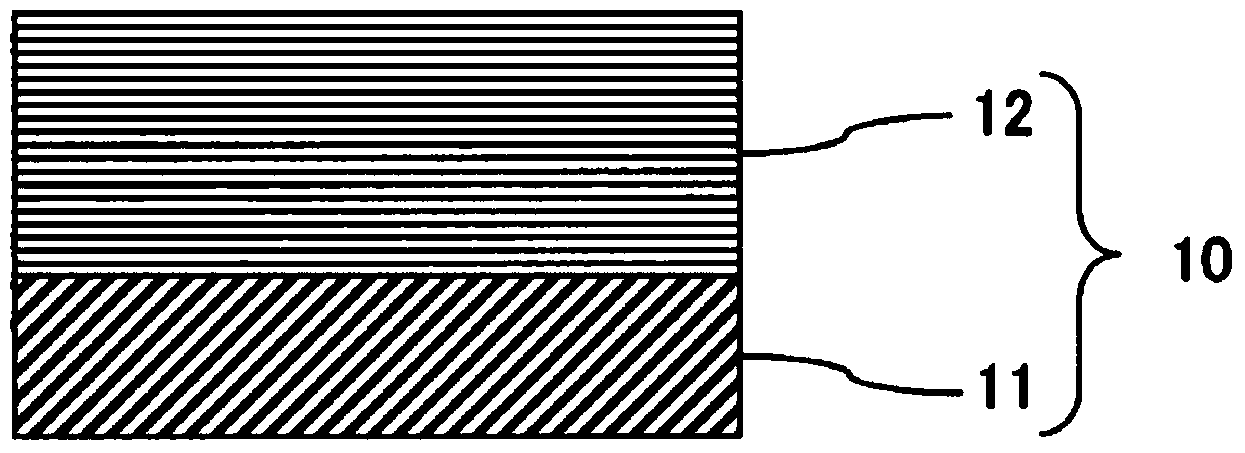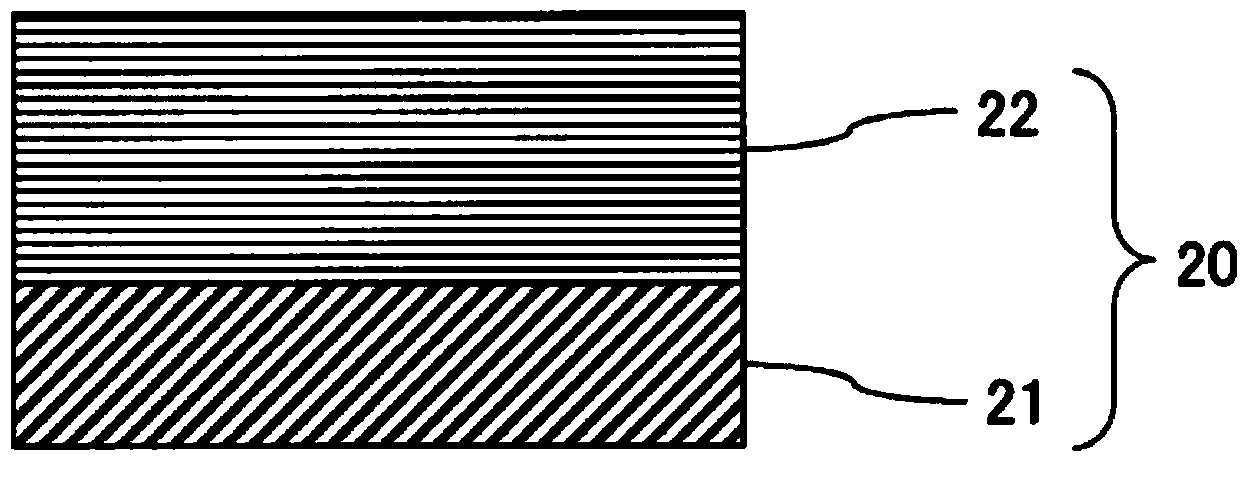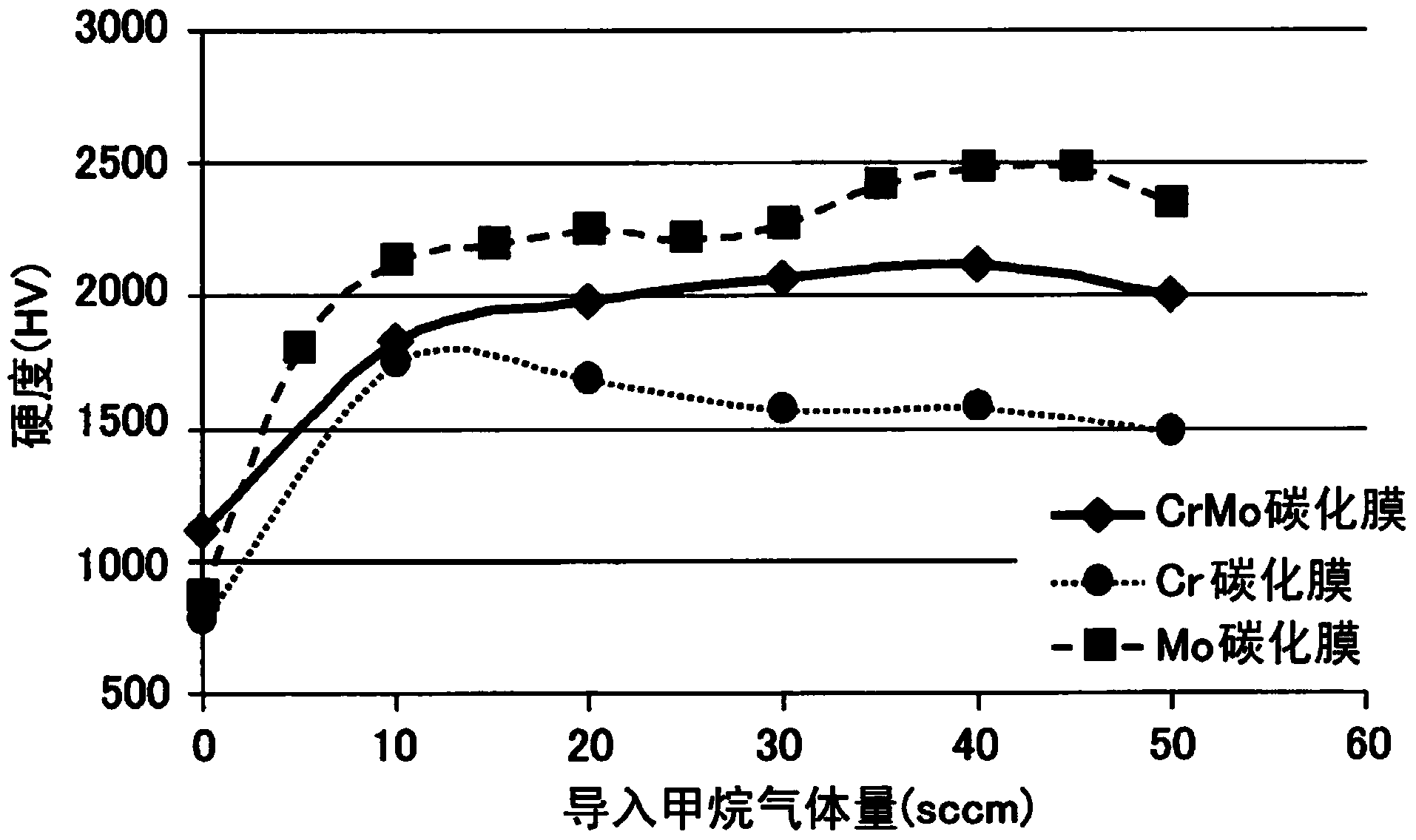Rigid decorative member
A decorative component and hard technology, applied in clothing, instruments, clocks and other directions, can solve the problems of low corrosion resistance, low brightness, and inability to thicken the film thickness of Mo coating, and achieve the effect of suppressing the deterioration of appearance quality
- Summary
- Abstract
- Description
- Claims
- Application Information
AI Technical Summary
Problems solved by technology
Method used
Image
Examples
Embodiment 1
[0083] In Example 1, as a sputtering target, a sintered body with Cr50wt% was used. Such as figure 2 As shown, as the base material 21, the SUS316L material stipulated in JIS is adopted, and a CrMo alloy carbide film with a thickness of 1.8 μm is formed on the base material 21 by the sputtering method used at a flow rate of 105 sccm Ar gas and a flow rate of 30 sccm. Hard decorative member 20 .
[0084] image 3 It is a graph comparing the film hardness of the CrMo alloy carbide film prepared by changing the amount of methane gas, and the film hardness of the Cr carbide film and the Mo carbide film. Furthermore, it can be seen that the CrMo alloy carbide film exhibits significantly higher hardness than the Cr carbide film, and also exhibits a high hardness not inferior to the Mo carbide film.
[0085] The scratch resistance performance is roughly determined by the product of the hardness of the wear-resistant layer, the film thickness of the wear-resistant layer, the degre...
Embodiment 2
[0095] In Example 2, as a sputtering target, a sintered body of Cr50wt%Mo50wt% was used similarly to the examples. Such as Figure 8 As shown, a SUS316L material specified in JIS was used as the base material 31 , and an adhesion layer 32 made of a CrMo alloy lower oxide of 0.1 μm was formed on the base material 31 by a sputtering method. Then, while introducing a small amount of oxygen, methane gas was increased in a gradient to form a gradient adhesive layer 33 of a 0.2 μm CrMo alloy oxycarbide film. Then, a 2.0 μm thin-film wear-resistant layer 34 composed of a CrMo alloy carbide film was formed. Then, methane gas was reduced in a gradient to form a color gradient layer 35 of 0.1 μm CrMo alloy carbide film, and the hard decorative member 30 was produced. The appearance color of the rigid decorative component 30 obtained in Example 2 is represented by the Lab color space as L*: 83.74, a*: 0.37, b*: 0.51, and the appearance color L* of the SUS316L substrate 31: 85.1, a*: 0...
Embodiment 3
[0102] In Example 3, as a sputtering target, a sintered body of Cr50wt%Nb50wt% was used. Such as Figure 10 As shown, a SUS316L material specified in JIS was used as the base material 41 , and an adhesion layer 42 composed of a CrNb alloy lower oxide of 0.1 μm was formed on the base material 41 by sputtering. Then, nitrogen gas was increased in a gradient while introducing a small amount of oxygen, thereby forming a gradient adhesive layer 43 of a 0.2 μm CrNb alloy oxynitride film. Then, a 1.8 μm thin-film wear-resistant layer 44 made of a CrNb alloy nitride film was formed. Then, nitrogen gas was reduced in a gradient to form a color gradient layer 45 of a 0.1 μm CrNb alloy nitride film to produce a hard decorative member 40 .
[0103] The appearance color of the rigid decorative member 40 obtained in Example 3 expressed based on the Lab color space is L*: 83.37, a*: 0.05, b*: 0.61, and the appearance color of the SUS316L substrate 41, L*: 85.1, a*: 0.38, b*: 2.34 are almo...
PUM
| Property | Measurement | Unit |
|---|---|---|
| hardness | aaaaa | aaaaa |
Abstract
Description
Claims
Application Information
 Login to View More
Login to View More - R&D
- Intellectual Property
- Life Sciences
- Materials
- Tech Scout
- Unparalleled Data Quality
- Higher Quality Content
- 60% Fewer Hallucinations
Browse by: Latest US Patents, China's latest patents, Technical Efficacy Thesaurus, Application Domain, Technology Topic, Popular Technical Reports.
© 2025 PatSnap. All rights reserved.Legal|Privacy policy|Modern Slavery Act Transparency Statement|Sitemap|About US| Contact US: help@patsnap.com



